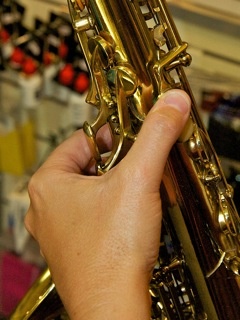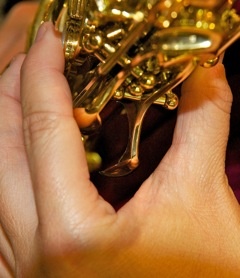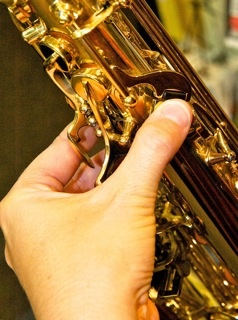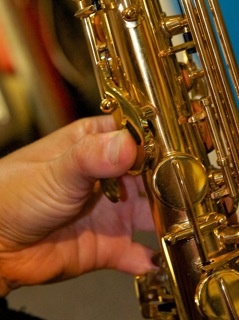The Good News! To many people, here is a pleasant surprise...
A good quality saxophone is probably the easiest wind instrument of all to play. You can look forward to being able to play simple tunes fairly quickly.
A sax looks like a really complicated musical instrument, however, the design and functions are very logical. If your saxophone is designed and made with quality, then you are off to a great start! A good quality sax will be easier to play, sound better, be more efficient, will require less costly maintenance and will give many years of reliability and enjoyment. It’s value will also be fairly well retained.
The “not so good” News – very important!
Being a mechanically based musical instrument, if the quality of design, materials or making is poor (read: unreasonably cheap) then the saxophone will be much more difficult to play – even when just starting out. Then, it’s lack of ability to keep functioning correctly over time, will eventually turn you off trying to play. There is no doubt that far too many people have given up on playing sax as a hobby, social activity or career just because they didn’t have a fair chance to start with – like anything else, you need good tools to do a good job! Dare we say – buy your fruit, milk and vegetables from a supermarket and buy your saxophone from a dedicated woodwind and brass music store.
The player blows air into a mouthpiece which has a reed (piece of shaped cane) placed underneath and attached by a clamp known as the ligature. The mouthpiece is then attached to the saxophone’s neck, which connects to the top of the sax body. The moving air causes the reed to vibrate and the vibration travels down the tube of the saxophone and out the bell (and other holes along the way). This vibration becomes the sound of the saxophone. As the player progressively depresses the keys in sequence, the holes (tone holes) in the body close up and the effective length of the vibrating tube becomes longer. The longer the effective length of tube, the lower the note produced.
Most people will start learning on an alto or tenor saxophone. If you are a younger player, under age 10 – 12, or physically slight, an alto sax will be best as it will be lighter and easier to manage. If you are older or physically stronger, then you may be able to chose either alto or tenor. Tenor has a lower note range than alto. Generally, the choice will be made by the type of music that you generally want to play. If you are in to blues, rock and jazz, then you may settle on tenor sax. Maybe your school wants you to play tenor sax to balance out the band which is already full up with alto players.
Alto sax has a higher “voice” and note range, and many teachers find that it is preferable for students to get a solid grounding with this member of the sax family. Possibly because it is smaller, lighter, requires a little less air volume to play, and is a really versatile instrument - capable of sounding good in just about any genre of music.
There are other instruments in the sax family – soprillo , sopranino, soprano, baritone, bass, contrabass and if you want to talk to us about these, please contact us or phone 03 9699 9099
Confused by varying information and opinions on which brand and model to buy? Stop worrying about brand names and model numbers, just think about quality and suitability first. Different brands and models of instruments, mouthpieces, reeds, ligatures & neck slings suit different individuals.
As a dedicated specialist store, we sell, guarantee and support quality brands and models knowing that the most suitable instrument (for you) in your price range will give you a great chance of success in learning and enjoyment. You are then provided with ongoing support from our in-store technicians to make sure that your musical investment keeps working correctly and efficiently.
These different brands of alto saxophones have completely different key positions for the left hand. Note that in Images 1 & 2, the student’s fingers and hand are forced into unnatural positions which make playing difficult (and probably painful). The smallest finger on each hand is the weakest finger, so if the design of the sax is not suited to the player’s hands, learning will be very difficult and slow.
If the sax is the “right one” then learning will be much more comfortable and quicker.
Left Hand Placement

Image 1. The keys that are operated by the smallest finger are pivoted from the player’s left side of the keys (instead of the right), so there is additional finger pressure needed to push these 4 keys down. The placement of the keys forces the small finger into a very uncomfortable position.

Image 2. The smallest finger keys are pivoted from the right and are in a completely different arrangement that requires less finger pressure. This finger still has to stretch a long way to operate the lowest positioned key. The 3rd finger looks more naturally placed than in Image 1.

Image 3. With this saxophone, the hand and fingers look far more natural and comfortable. Even a very small difference in the shape or position of the keys makes a huge difference in avoiding discomfort and encouraging playing enjoyment.
Images 4, 5, 6 & 7 show the “Palm Keys” that are placed within the palm of the left hand. The Palm Keys can vary in length by up to 1 cm with these different saxophones. The angles of motion and positions vary also. Your thumb operates the octave key at the back of the sax body, and your fingers operate the keys on the front of the sax body. If the palm keys protrude too far into your hand, you may not be able to play some notes without accidentally pressing wrong keys. Often this problem causes a “squawking” sound. If the keys are too short, you will need to move your hand position constantly to be able to operate the palm keys. Neither situation is ideal. Overall, the right instrument vs player matching works best.




The Octave Key takes you from the lower notes to the higher notes of the saxophone and is operated by your left hand thumb. For more than the first 50 years of saxophone production, this key was pivoted from the right to the left. Because your thumb pivots from the left to the right, eventually most makers changed the basic design so that the key follows the natural arc of your thumb. Generally, we would recommend that beginner sax players will find the modern octave mechanism more effective however, for some younger sax students, the older style mechanism may be more suitable, This is a very important decision and you may need our help.
Different saxophone manufacturers have different ideas of shapes, designs, positioning and mechanics of the octave mechanism. For you, some will be work better and be more suitable than others.



The Music Place is famous, not only for it's diverse, large and constantly evolving range of saxophones, but also because of the way that we work through a very comprehensive saxophone selection process which has been successfully proven for decades. This enables buyers (and us) to identify the most appropriate instrument (or instruments for selection) relative to each individual’s criteria.
We recommend that you visit The Music Place store to see and play our extensive collection of saxophones and mouthpieces. Allow plenty of time - you are going to have a lot of fun!
Unable to visit us in person? Then phone 03 9699 9099 and talk to us. Alternatively, if you are confident about which instrument to buy, then please click here for alto saxophones or tenor saxophones. We check our pricing regularly and you can be assured that although we provide the highest level of backup support and advice, our pricing is always competitive.
rental option, interest free.